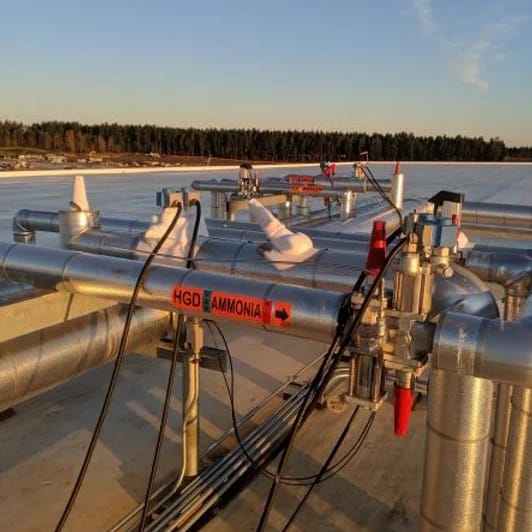Many different industries use ammonia as a refrigerant, including dairy and ice cream plants, cold storage warehouses, petrochemical plants, and a variety of other food processing facilities. Identifying and controlling hazards posed by ammonia refrigeration systems is imperative for those who operate and maintain them. These hazards will cause catastrophic injuries and even death if ammonia is released accidentally.
In the business of refrigeration, Ice Cold Consulting has been around for many years. They manage to stay up-to-date by always being informed about ammonia refrigeration safety because their highly skilled technicians and engineers know the guidelines very well. Management must always follow strict safety guidelines during handling of ammonia to protect employees’ health.
The EPA’s Risk Management Program (RMP) for Chemical Accidental Release Prevention and OSHA’s Process Safety Management (PSM) of Highly Hazardous Chemicals guidelines apply to all ammonia refrigeration systems with 10,000 pounds or more of ammonia refrigerant. Occupational safety and health standards are designed to ensure a safe and healthy workplace and protect both workers and the public from chemical releases.
In the absence of an ammonia charge greater than 10,000 lbs, a facility does not need to comply with PSMs or RMPs, but rather with general duty clauses set out by both OSHA and EPA. To assist facilities which are subject to the GDC, IIAR offers the Ammonia Refrigeration Management (ARM) Program. For facilities operating relatively small ammonia systems, this voluntary program was designed to help them operate safely and responsibly.
According to the International Institute of Ammonia Refrigeration (IIAR) guidelines, it is highly recommended that a voluntary Ammonia Risk Management Program (ARM) be implemented.
The Ammonia Refrigeration Management Program (ARM)
There are 12 elements in the ARM Program:
Section 1 – Management System
ARM Program development and maintenance is carried out by experienced personnel, which ensures the program’s success. The element includes the names of the people responsible for each element of the ARM software. Employees are also allowed access to and participation in the ARM Program within this element. Clear responsibilities and authority lines can only be achieved with a program management system. Each ARM-LC Program element has its own responsibilities, as defined by a good program management system.
Section 2 – Documentation for refrigeration systems
Guidelines for compiling refrigeration system documentation are included in this element. A hazard review of the facility can be conducted with this information. Provides an overview of the technical documentation the manufacturer should provide, or the contractor should develop. The documentation for most refrigeration systems should come from the manufacturer or installation contractor. Documentation is the owner’s primary responsibility.
A refrigeration system comprises cooling data sheets, ammonia inventories, design protocols, ventilation design guidelines, operating ranges, pressure safety relief designs, safety systems, design codes and standards, materials of construction, and good engineering practices.
Section 3 – Hazard Analysis
It identifies, evaluates, and controls potential hazards in order to prevent accidental release. Safety reviews of potentially hazardous equipment should be performed by manufacturers. Safety reviews should be conducted by contractors installing the equipment along with end users. Employers can make better safety decisions if they conduct hazard assessments, reducing the likelihood of catastrophic ammonia releases.
Section 4 – Operating and Maintenance Procedures
Operator & maintenance procedures should be provided by the manufacturer of packaged systems, or by the contractor installing them. In the event of changes, the owner is responsible for ensuring that procedures are implemented and updated. In order to ensure systems operate ammonia refrigeration systems safely, clear, standardized guidelines, guidelines, rules, and practices have been developed, implemented, and maintained.
Section 5 – Preventative Maintenance
A properly maintained ammonia refrigeration system is necessary. The services included here are preventative maintenance, inspections, testing, nondestructive testing (NDT), and third-party inspections. Using standards such as IIAR’s Inspection, Testing, and Maintenance of Closed-Circuit Ammonia Refrigeration Systems (ANSI/IIAR-6) when planning routine maintenance and inspection tasks is a good engineering practice.
Section 6 – Training
Low charge ammonia refrigeration systems are typically designed to operate unattended with controlled operation. Therefore, installation contractors and manufacturers often provide training. Owners must ensure their servicing companies are credentialed and that emergency action plans are in place.
Section 7 – Compliance Audit
It determines whether the procedures and practices associated with the ARM Program are followed on each element. Owners must ensure that refrigeration management programs are reevaluated regularly to address safety issues or legal requirements.
Section 8 – Incident Investigations
An owner is responsible for initiating an investigation when an incident occurs. A servicing contractor will often be sought out by a property owner when conducting an incident investigation.
Section 9 – Contractors
Contractors, subcontractors, and their employees must understand how to protect themselves since OSHA and EPA have a General Duty Clause that addresses this issue.
Section 10 – Action Plan/Response to Emergency
Upon installing the low charge ammonia refrigeration system on the site, the owner has the primary responsibility to update any existing emergency plans and/or emergency response programs.
Section 11 – Environmental Safety Evaluation
Design consultants, manufacturers and installers may provide the initial evaluation of environmental safety. Upon implementation and completion of the service agreement, it is the owner’s responsibility to ensure that the first environmental safety evaluation is performed. An annual review follows.
Section 12 – Program for managing change
In this element, the guidance is provided for the management of changing ammonia refrigeration process elements, such as adding new equipment or changing operation, maintenance, or other procedures. Chemical changes, equipment modifications, procedure changes, technology changes, or adjustments made to the facility that affect the process are examples of changes.
Final thoughts:
The general rule is that companies treat General Duty storage facilities as if their weight exceeds 10,000lbs, for the same reasons: brand protection – you never want to be in a position where you have to argue that you haven’t met the required level of safety for employees or the community!
Therefore, make sure that your employees are as safe as possible by getting the ARM program guidelines.



